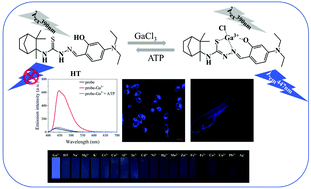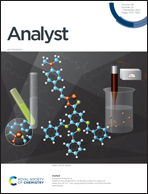An isocamphanyl-based fluorescent “turn-on” probe for highly sensitive and selective detection of Ga3+ and application in vivo and in vitro†
Abstract
A novel fluorescent probe 2-(4-(diethylamino)-2-hydroxybenzylidene)-N-(2,3,3-trimethylbicyclo[2.2.1]heptan-2-yl)hydrazinecarbothioamide (HT) was prepared in this study by a condensation reaction. HT has been confirmed to possess high specificity toward Ga3+ over other metal ions (including Al3+ and In3+) via a distinct fluorescence light-up response. Moreover, HT exhibited good detection performances for Ga3+ including high selectivity, excellent anti-interference ability, a wide working pH range, and good reversibility. The association constant and limit of detection (LOD) were calculated to be 5.34 × 103 M−1 and 1.18 × 10−6 M, respectively. The detection mechanism of HT toward Ga3+ was proposed and confirmed by 1H NMR analysis, HRMS analysis, and DFT calculations. A simple test strip-based portable detecting device and a molecular INHIBIT logic circuit were established for improving its practical applicability. Furthermore, the desirable sensing performance of HT for Ga3+ was successfully reconfirmed in MCF-7 cells and zebrafish.



 Please wait while we load your content...
Please wait while we load your content...